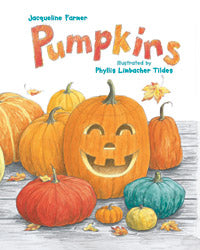Pumpkins

Jacqueline Farmer, author
Jacqueline Farmer is the author of Bananas! and O Christmas Tree. She lives in Greensboro, North Carolina.
Read more about Jackie.
Phyllis Limbacher Tildes, illustrator
Phyllis Limbacher Tildes has written and illustrated many books for children, including Animals Black and White and Animals in Camouflage. She lives in Savannah, Georgia.
Read more about Phyllis.
- Ohio Farm Bureau Award for Children's Literature
- IRA Children's Book Award Notables
NSTA Recommends
In Pumpkins, the perennial fall fruit--from red, white, or blue to the Atlantic Giant-is pictured in all its glory. The author identifies the scientific classification of pumpkins and their historical significance. It will be a great reference for elementary teachers, especially those who incorporate "pumpkin science" or "pumpkin math" into their fall curricula.
Students will learn about the life cycle of a pumpkin from carefully planted seed to vine, flower, and fruit. The process is beautifully illustrated, and students will be amazed to learn that a pumpkin is actually a berry.
The author traces the history of the pumpkin back thousands of years, and students will grow to understand their importance as food and medicine in the Americas. Although pumpkins were an essential food source for early American settlers, nine out of ten of today's pumpkins are carved into jack o' lanterns rather than eaten.
The author shares two stories about the origin of carving pumpkins and includes directions for creating a jack o' lantern with an adult's help. There are even recipes for pumpkin-maple pie and toasted pumpkin seeds! Pumpkins is a wonderful resource for an elementary classroom, and I will be sharing it with my class this season. The book may be used as a read-aloud or for independent reading. A list of additional books and websites will provide readers with even more learning opportunties.
School Library Journal
In a conversational style, Farmer relates facts, history, legend, and growing tips about one of the favorite fruits of fall. In addition to the de rigueur instructions on pumpkin carving a (and safety) and seed toasting, the author includes the word for the berry in other languages, a brief list of pumpkin world records, and recommended readings and Web sites. The serviceable watercolor-and-pencil illustrations feature a multicultural cast of bright-eyed, slightly stiff young children; the art is surrounded by plenty of white space. More detailed than Gail Gibbons's The Pumpkin Book (Holiday, 1999) and less poetic than George Levenson's Pumpkin Circle (Tricycle, 2004), this holiday patch of pumpkin facts will find a place in collections looking for material for Halloween and harvest time.
Bay Views
Containing pumpkin lore for primary grades, this will be in demand in October and November, and teachers will find it useful. A solid supplement to Gail Gibbons' The Pumpkin Book (Holiday, 1999) and George Levenson's Pumpkin Circle: The Story of a Garden (Tricycle, 1999), the watercolor and pencil illustrations give this a picture book appearance at first glance. But it is factual, with information on growing pumpkins, the tradition of jack-o-lanterns, recipes, and list of related websites.
Jacqueline Farmer pays tribute to fall's favorite fruit in Pumpkins. Like seeds in the familiar, fat Halloween staple, this book is stuffed with fun facts. Kids learn how to carve their own jack-o-lanterns and that this spooky symbol came out of an Irish folktale about a foolish man and his candle-lit turnip. They can follow a seed from planting to growing to deliciously filling a piecrust (recipe included). They can even call pumpkins by their names in other languages: the Italian zucca, Mexican calabaza, or (my favorite) the Swedish poompa. Watercolors by Phyllis Limbacher Tildes capture the charm and many functions of this popular fruit.
NSTA Reports
In Pumpkins, author Jacqueline Farmer identifies teh scientific classification of pumpkins and their historical significance. K-4 students will learn about the life cycle of a pumpkin from planted seed to vin, flower, and fruit. A list of additional books and web-sites can provide readers with even more learning opportunities. NSTA Recommends reviewer Judy Kraus says that this book is "a great reference for elementary teachers, especially those who incorporate 'pumpkin science' or 'pumpkin math' into their fall curricula."
Paperback
ISBN: 978-1-57091-558-1
E-book PDF
ISBN: 978-1-60734-325-7
Spanish Language Edition
ISBN: 978-1-57091-696-0
Ages: 5-8
Page count: 32
8 1⁄2 x 11






